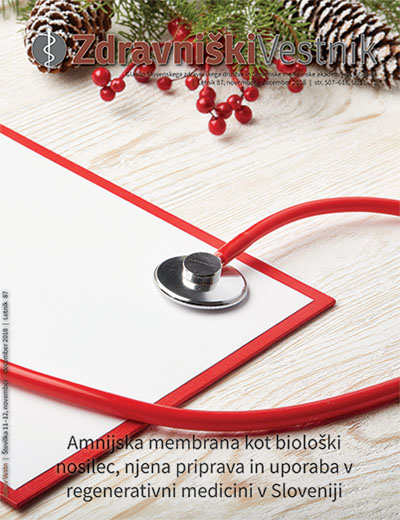Cardioneuroablation as a treatment for reflex neurocardiogenic syncope – case report
Abstract
Abstract
Reflex neurocardiogenic syncope is one of the most common causes of transient loss of consciousness. Pathophysiological mechanism consists of an excessive response of parasympathetic nervous system, which leads to a drop in blood pressure and/or heart rate. Reflex neurocardiogenic syncope is usually not associated with any organic disease, it has a good prognosis and mortality is not increased. The goal of treatment is improving patient's quality of life. For patients with frequent episodes of reflex neurocardiogenic syncope with predominant cardioinhibitory component, who are unresponsive to all nonpharmacological and pharmacological methods of treatment, and pacemaker implantation is not indicated, there is now a new treatment possibility - cardioneuroablation. In this percutaneous electrophysiological procedure epicardial parasympathetic ganglia are ablated with radiofrequency energy. The result is a partial parasympathetic denervation of the heart, which leads to reduction of parasympathetic influence on heart and hence resolution of symptoms.
Downloads
References
da Silva RM. Syncope: epidemiology, etiology, and prognosis. Front Physiol. 2014 Dec;5:471. https://doi.org/10.3389/fphys.2014.00471 PMID:25538626
Chen-Scarabelli C, Scarabelli TM. Neurocardiogenic syncope. BMJ. 2004 Aug;329(7461):336–41. https://doi.org/10.1136/bmj.329.7461.336 PMID:15297344
Kurbaan AS, Bowker TJ, Wijesekera N, Franzén AC, Heaven D, Itty S, et al. Age and hemodynamic responses to tilt testing in those with syncope of unknown origin. J Am Coll Cardiol. 2003 Mar;41(6):1004–7. https://doi.org/10.1016/S0735-1097(02)02967-4PMID:12651049
AHA. Syncope (Fainting). Dallas: American heart associacion; c1924-2017. [citirano 2017, Mar 23]. Dosegljivo na : http://www.heart.org/HEARTORG/Conditions/Arrhythmia/SymptomsDiagnosisMonitoringofArrhythmia/Syncope-Fainting_UCM_430006_Article.jsp#.WQZp6hPyjIU
Kapoor WN. Syncope. N Engl J Med. 2000 Dec;343(25):1856–62. https://doi.org/10.1056/NEJM200012213432507 PMID:11117979
Fogoros RN. Practical cardiac diagnosis: electrophysiologic testing. 3rd ed. Malden (MA): Blackwell Publishing; 1999.
DiBona GF, Kopp UC. Neural control of renal function. Physiol Rev. 1997 Jan;77(1):75–197. https://doi.org/10.1152/physrev.1997.77.1.75 PMID:9016301
Zucker IH. Left ventricular receptors: physiological controllers or pathological curiosities? Basic Res Cardiol. 1986 Nov-Dec;81(6):539–57. https://doi.org/10.1007/BF02005179PMID:3545177
Bertolassi C. Cardiology 2000. Volume 1. Buenos Aires: Panamericana; 2000. pp. 156–8.
White CM, Tsikouris JP. A review of pathophysiology and therapy of patients with vasovagal syncope. Pharmacotherapy. 2000 Feb;20(2):158–65. https://doi.org/10.1592/phco.20.3.158.34786 PMID:10678294
Zaqqa M, Massumi A. Neurally mediated syncope. Tex Heart Inst J. 2000;27(3):268–72. PMID:11093411
Nair N, Padder FA, Kantharia BK. Pathophysiology and management of neurocardiogenic syncope. Am J Manag Care. 2003 Apr;9(4):327–34. PMID:12703677
Pachon JC, Pachon EI, Pachon JC, Lobo TJ, Pachon MZ, Vargas RN, et al. “Cardioneuroablation”—new treatment for neurocardiogenic syncope, functional AV block and sinus dysfunction using catheter RF-ablation. Europace. 2005 Jan;7(1):1–13. https://doi.org/10.1016/j.eupc.2004.10.003 PMID:15670960
Pachon JC, Pachon EI, Cunha Pachon MZ, Lobo TJ, Pachon JC, Santillana TG. Catheter ablation of severe neurally meditated reflex (neurocardiogenic or vasovagal) syncope: cardioneuroablation long-term results. Europace. 2011 Sep;13(9):1231–42. https://doi.org/10.1093/europace/eur163 PMID:21712276
Aksu T, Golcuk E, Yalin K, Guler TE, Erden I. Simplified Cardioneuroablation in the Treatment of Reflex Syncope, Functional AV Block, and Sinus Node Dysfunction. Pacing Clin Electrophysiol. 2016 Jan;39(1):42–53. https://doi.org/10.1111/pace.12756 PMID:26411271
Liang Z, Jiayou Z, Zonggui W, Dening L. Selective atrial vagal denervation guided by evoked vagal reflex to treat refractory vasovagal syncope. Pacing Clin Electrophysiol. 2012 Jul;35(7):e214–8. https://doi.org/10.1111/j.1540-8159.2011.03320.x PMID:22303858
Scanavacca M, Hachul D, Pisani C, Sosa E. Selective vagal denervation of the sinus and atrioventricular nodes, guided by vagal reflexes induced by high frequency stimulation, to treat refractory neurally mediated syncope. J Cardiovasc Electrophysiol. 2009 May;20(5):558–63. https://doi.org/10.1111/j.1540-8167.2008.01385.x PMID:19207753
Zhao L, Jiang W, Zhou L, Wang Y, Zhang X, Wu S, et al. Atrial autonomic denervation for the treatment of long-standing symptomatic sinus bradycardia in non-elderly patients. J Interv Card Electrophysiol. 2015 Aug;43(2):151–9. https://doi.org/10.1007/s10840-015-9981-8PMID:25693516
Shen WK, Sheldon RS, Benditt DG, Cohen MI, Forman DE, Goldberger ZD, et al. 2017 ACC/AHA/HRS Guideline for the Evaluation and Management of Patients with Syncope. Heart Rhythm. 2017;14(8):155–217. https://doi.org/10.1016/j.hrthm.2017.03.004.
Benditt DG, Sutton R, Gammage MD, Markowitz T, Gorski J, Nygaard GA, et al.; The International Rate-Drop Investigators Group. Clinical experience with Thera DR rate-drop response pacing algorithm in carotid sinus syndrome and vasovagal syncope. Pacing Clin Electrophysiol. 1997 Mar;20(3 Pt 2):832–9. https://doi.org/10.1111/j.1540-8159.1997.tb03916.xPMID:9080522
Kurbaan AS, Franzén AC, Heaven D, Mathur G, Bowker TJ, Petersen M, et al. Cardioinhibition during tilt testing identifies patients who may benefit from pacing. Pacing Clin Electrophysiol. 2000 Nov;23(11 Pt 2):1792–4. https://doi.org/10.1111/j.1540-8159.2000.tb07020.x PMID:11139925
Lellouche N, Buch E, Celigoj A, Siegerman C, Cesario D, De Diego C, et al. Functional characterization of atrial electrograms in sinus rhythm delineates sites of parasympathetic innervation in patients with paroxysmal atrial fibrillation. J Am Coll Cardiol. 2007 Oct;50(14):1324–31. https://doi.org/10.1016/j.jacc.2007.03.069 PMID:17903630
Chiou CW, Eble JN, Zipes DP. Efferent vagal innervation of the canine atria and sinus and atrioventricular nodes. The third fat pad. Circulation. 1997 Jun;95(11):2573–84. https://doi.org/10.1161/01.CIR.95.11.2573 PMID:9184589
Zhao L, Jiang W, Zhou L, Wang Y, Zhang X, Wu S, et al. Atrial autonomic denervation for the treatment of long-standing symptomatic sinus bradycardia in non-elderly patients. J Interv Card Electrophysiol. 2015 Aug;43(2):151–9. https://doi.org/10.1007/s10840-015-9981-8PMID:25693516
Aksu T, Güler TE, Bozyel S, Özcan KS, Yalın K, Mutluer FO. Cardioneuroablation in the treatment of neurally mediated reflex syncope: a review of the current literature. Turk Kardiyol Dern Ars. 2017 Dec;45(1):33–41. PMID:28106018.

The Author transfers to the Publisher (Zdravniški vestnik/Slovenian Medical Journal) all economic copyrights following form Article 22 of the Slovene Copyright and Related Rights Act (ZASP), including the right of reproduction, the right of distribution, the rental right, the right of public performance, the right of public transmission, the right of public communication by means of phonograms and videograms, the right of public presentation, the right of broadcasting, the right of rebroadcasting, the right of secondary broadcasting, the right of communication to the public, the right of transformation, the right of audiovisual adaptation and all other rights of the author according to ZASP.
The aforementioned rights are transferred non-exclusively, for an unlimited number of editions, for the term of the statutory
The Author can make use of his work himself or transfer subjective rights to others only after 3 months from date of first publishing in the journal Zdravniški vestnik/Slovenian Medical Journal.
The Publisher (Zdravniški vestnik/Slovenian Medical Journal) has the right to transfer the rights, acquired parties without explicit consent of the Author.
The Author consents that the Article be published under the Creative Commons BY-NC 4.0 (attribution-non-commercial) or comparable licence.


